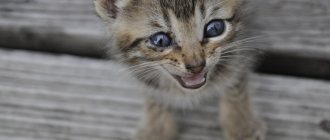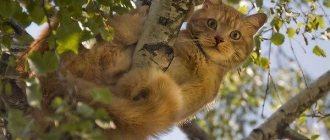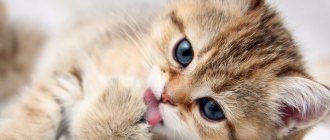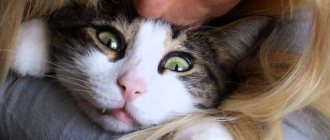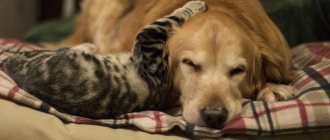Anyone who has interacted with a friendly cat or examined a cat's tongue up close knows that it is unique in many ways. The cat's tongue is truly unusual, it is long, flexible and has a very rough surface. In addition, it is also a multi-functional tool. Scientists studying a cat's tongue under a microscope have only recently discovered just how amazing it is in terms of its anatomy and abilities.
The structure of a cat's tongue
Have you ever watched a slow motion video of a cat drinking water? Its tongue acts like a tiny ball that draws water from the bowl and pushes it in a column directly into the animal's mouth. The jaws tighten around the thick water and she swallows. This all happens too quickly for the human eye to see the process in real time, but looking at the slow motion video, you'd think this technique seems to defy gravity!
There is something in common between cat and human tongues: they are both composed of transverse and longitudinal muscles. They provide mobility to this organ, which can move in different directions. A special arrangement of muscles helps these animals fold their tongue like a ladle.
Muscle tissue is covered with mucous membrane. On the outer shell there is a layer of keratin, which performs a protective function. Beneath it are capillaries that supply the organ with blood. Receptors on the surface allow you to detect bitter, sour and salty. However, cats do not distinguish sweet taste, since scientists have not found the corresponding formations in them.
The papillae on the surface of the tongue, similar in appearance to denticles, are opaque, covered with keratin, and protrude from expanded bases covering the tongue. The teeth are longer in the center and gradually become shorter on the sides and front.
Cat tongue close up
Structure and functions of language
The cat's tongue consists of transverse and longitudinal muscles that provide its flexibility and mobility. Cats can pull it strongly, move it in different directions, and roll it into a ladle shape (for example, while drinking). Primarily, this organ is used for eating. However, it also provides thermoregulation. With its help, the cat cools its skin by licking itself intensively in hot weather. A tongue sticking out can be an indicator of overheating of the animal's body.
The upper layer of the tongue is covered with special hard papillae that resemble thorns. The animal needs them not only to hold food or drink in its mouth, but also to thoroughly clean the fur, remove accumulated dirt and large insects. Thanks to this property, cats practically do not need to be washed, unlike dogs. However, cats cannot remove all the cleaned debris (including hairs) from the tongue and swallow it. Therefore, the owner should help his pet in caring for the fur to prevent its accumulation in the animal’s intestines.
Why do cats have rough tongues?
If your pet has ever licked your hand, you will certainly feel the rough surface of his tongue. The feeling of being touched with sandpaper is caused by the papillae located on the surface of the tongue. They play an important role in helping cats stay clean and healthy. They face back towards the animal's throat, and this peculiar anatomy of the papillae allows these animals to tidy up their fur (much better than a comb). It also allows our carnivorous friends to peel meat from bones using only their tongues.
These bumps are hook-shaped and give that rough, bristly appearance that causes a “sandpaper effect” when in contact with the skin. This special structure is a kind of survival factor: by removing any dirt from the fur, the animals eliminate all traces of odors that could jeopardize hunting or could turn them into prey for other animals (there's a reason they lick their lips after they've finished eating).
Let's watch the cat
A cat is a very neat animal; it always keeps its fur in order. Observe her behavior. Before curling up into a cozy ball, a cat will certainly groom its fur, wash its face with its paw and its tongue plays the most important role in this matter.
Natural comb for cats
Its entire surface is covered with small points that resemble hooks. They are directed towards the pharynx, covered with keratin (our nails are made of this substance). That is why, by licking you, showing its love and tenderness, a cat can cause minor pain, discomfort, small hooks scratch like sandpaper. This quality of a cat's tongue can be compared to the action of a comb. Just as a person combs and smoothes his hair, a cat performs similar actions with its tongue.
Cats are given the opportunity to carefully care for their fur, which cannot be said about dogs; they do not have such sharp hooks on their tongues, they are not able to untangle tufts of fur. It is worth noting that although cats have such an effective grooming tool, they do not always use it. Very often, lazy cats, overweight cats, sick animals, or simply spoiled, self-satisfied specimens do not bother to lick all areas of the body. They often leave this work to their owners.
If you have already taken on the responsibility of a cat caretaker, then carefully inspect the fur to avoid the formation of stray lumps (tangles).
What can be seen under a microscope
B0009732 Cat tongue, cross section
The first composite image of a section of a cat's tongue applied to a microscope slide is over a hundred years old. Yellow stripes are horizontal muscles, sparse purple stripes are vertical muscles, and black swirls are capillaries. These blue-violet spots on the jagged edge represent polarized light interacting with the keratin. A microscope image of a cat's tongue was taken by David Linstead.
Enlarged photo of a cat's tongue
This photo of a cat's tongue shows a 3mm cross section. This is a picture of 30 microphotographs taken using a digital camera and microscope. A close-up of the serrated ridge on top of the plate on the cat's tongue is the same papillae located on the surface. Under a regular microscope, a cat's tongue up close looks like a rough surface filled with thousands of tiny teeth, which is clearly visible in the photograph.
How do cats drink water? Slow motion
Many people believe that a cat's tongue is also used as a spoon to lap up water. Although the tongue is an important part of the drinking process, it was only recently that scientists made an incredible discovery about exactly how the lapping process occurs.
Using high-speed imaging, scientists were able to understand what happens when a cat drinks water. Instead of curling their tongue into a spoon, cats actually twist the tip of their tongue in the opposite direction and then quickly flick it across the surface of the water.
This particular action causes a column of water to rise from the surface. The animal then quickly closes its mouth, just in time to catch the water before gravity brings it back to the surface. How quickly does all this happen? Very fast! A cat is capable of dipping its tongue into water at a rate of about four times per second, which explains why the process is invisible to the naked eye.
Source
Functions of a cat's tongue
Mother Nature has equipped every cat with an anatomical Swiss Army knife. Strong and incredibly durable, used for eating and grooming, this tool is that very language. It's easy to underestimate how important he is to her health and happiness. Not only does it have a rough texture that helps with grooming and eating, but it has many other beneficial features.
Cat's sense of taste
Cats have fewer taste buds compared to humans. This affects their perception of tastes: they do not recognize sweet tastes, but they like savory tastes. While the human tongue is primarily designed for eating and pleasure, in cats this organ works differently.
Interestingly, they can taste adenosine triphosphate (ATP), which is found in living cells such as meat, but humans cannot. This is thought to naturally encourage the furry carnivores to eat meat, which is why they are carnivores. This means that they can consume other types of food such as vegetables and grains, but their diet should consist mainly of meat.
Natural wool brush
The cat washes itself
If you have a cat, then you probably know how carefully she takes care of her fur. Most of them spend a lot of time every day taking good care of themselves. Due to the special structure and presence of papillae, the tongue performs the function of a comb.
Unfortunately, this feature also has a downside. Because of their shape, these hooks tend to catch any hairs that fall out during grooming. What gets stuck on the tongue is usually swallowed. This is why many pets sometimes have to get rid of hairballs that accumulate in their stomach.
Other language properties
A cat can only drink thanks to this organ: they bend it backwards, making it look like a spoon, dipping only the tip into the water and lifting it up, sucking up the water at incredible speed before it can fall back into the bowl. This movement is very fast; in a second she manages to repeat it four times.
Seals use their tongue to regulate their body temperature. When they are hot, they cool down and restore their body temperature by licking themselves: in doing so, they moisten the fur, the saliva evaporates, thus reducing body heat.
The tongue plays an important role in the chewing process. As we mentioned earlier, thanks to this structure, meat is more easily separated from the bones of the victim, in addition, this organ helps to eat faster.
Along with the ability to detect taste, a cat's tongue is also able to sense texture and temperature. These three things - taste, temperature and texture - are the main criteria that determine a cat's food and water preferences.
Language helps strengthen bonds with offspring. Mother cats usually lick their kittens as a sign of affection. In the same way, she helps them stay clean.
The cat drinks water
The secret language of cats (9 photos)
A cat in the house is a full-fledged member of the family who can not only give affection, but also make claims. How to understand the innermost thoughts of your pet, learn cat language and establish relationships? Learning the language of cats.
Who said "meow"?
It is curious that most of the cat's words are reserved exclusively for people. To communicate with their fellow cats, cats only need body language. Our pets make sounds in the same way as a person, passing air from the lungs through two elastic ligaments of the larynx. Unlike humans, a cat does not use its tongue to form individual sounds, but produces thirteen distinct vowels by tension in the throat, sinuses and lips. To change the resonance, it opens and opens its mouth, changing its shape. Cats make three main groups of sounds: purrs, calls and screams. The first are heard from a closed mouth, the second pass through an open mouth, and the third - from a tense and constantly open mouth. In addition, the cat produces about eight consonants. Since cats combine possible sounds, the range of their “speech” is much wider than that of humans. Having this information, you can not lose hope of teaching Murka the simplest phrases or at least the sentimental “mother”. Purr
Every cat owner knows that a pet's purring is a sure sign of contentment with what is happening. But purring is not the same type and carries, although similar, but diverse information. The rougher the rumbling and the more distinct the sounds in each beat, the higher the degree of pleasure the animal experiences. The purr becomes soft when the cat is bored and begins to doze off. If the notes become higher and a high-frequency sound “r-r-r” is added, then the cat requires increased caresses. Sometimes a cat purrs when she feels unwell and in pain, this may be obvious during childbirth or after an illness. The purr can also be a welcoming purr, when the kitty runs towards you and makes a sound similar to “mr-mr-mr”. Very similar is the cat's inviting purr, but it starts with an "h" sound and sounds more like "hmm-hmm-hmm", which means "come here", and the accent varies from quiet gentle to loud demanding. Particularly beautiful is the appreciative purring, reminiscent of the sounds “mmnngg”, which are pronounced while inhaling, and the pitch of the sound quickly drops. This treatment translated means “thank you.” Appeals
A cat makes this type of sound by opening its mouth, and all of them are derivatives of the familiar “meow”. Vowels as you inhale and consonants as you exhale combine to make a sound like “m-r-r-r-m-m-a-a-a-o-o-o-o-o-o.” In this way, the pet voices its demands, whether it be affection, food, or just your attention. If demands are not met, the sound becomes louder, clearer and more insistent. Sometimes the cat switches to a “pleading demand” with special emphasis on the vowels, and then the sound turns into “m-r-r-r-m-m-a-a-a-o-o-o-u-u-u- y". At this moment, the cat behaves like a small child, turning to the owner something like “please, please, please!” If the cat is worried or suddenly decides that its calls are not achieving the intended effect, the demands become uncertain and look like “m-a-o-o-o-o-o-o,” and later they develop into a complaint. The pitiful call is similar to “m-m-n-g-a-a-o-u” and is pronounced by swallowing. This type of communication can be very significant, for example, when the vowel part sounds drawn-out, the cat asks “how could you do that?!”, and you will have to make a lot of effort to restore your authority in the eyes of your fastidious pet. Rare sounds
Have you ever witnessed a cat fight? This is exactly the case when body language is no longer enough, and cats deliberately make tense, loud sounds during a showdown. A loud and drawn-out “vvvaaaaauuvv” is accompanied by a tilt of the head and a fixed gaze at the opponent. This is a very stressful and unusual state for a cat, but it is almost impossible to distract it from the object of anger at this moment. More often, cats make hissing sounds, for example, a short “pfft” when scared. Cat language has a distinct "chsh-chsh-chsh-chsh" sound that the cat uses to indicate territory. If an unfamiliar animal appears in the room where a cat lives, then the owner of the territory suspects an encroachment on her property and tries with all her might to show the stranger who is in charge. During the hunt, you can hear a soft clicking sound from the cat. Most often it is noticed by owners of urban domestic cats and cats when their pets watch the birds from the windowsill. These sounds help the hunter communicate with her “friends” without scaring off the prey. Language of the body
A cat's behavior will tell you much more than monologues. Pay special attention to the tail: soft waving from side to side means interest, sharp ones indicate excitement and irritation. Tail twitching also occurs in several cases - a cat will look at something curious and twitch the tip of its tail, or rub its tail against your legs in a similar motion, thus showing affection, and a cat will twitch its tail when marking territory. The second important detail is your pet’s ears. If a cat pricks up its ears, it means that it is carefully studying what is happening. If the ears are flat against the head and turned back, the cat is in a defensive position, feeling threatened and ready to attack. The whiskers are also an important indicator of the cat's mood: if they are forward, then the cat is relaxed and happy, if they are pulled back, then the cat is tense and ready to defend itself. There are several short and simple signs of a certain mood in a cat. For example, shuffling your paws is a sign of love, satisfaction and well-being. If the cat rolls over on its back and allows you to touch its stomach, it means that it completely trusts you. Pay attention to surrounding factors, they can be nuances for “reading” a cat’s thoughts. For example, an arched back in a cat can mean both a readiness to fight and a friendly desire to play. A real fight is usually accompanied by raised fur, wide eyes and flattened ears. Actions and behavior
It is not a fact that you have come across a “talkative” and sociable pet who will never tire of demanding what is necessary, being indignant at what is unnecessary and expressing gratitude and love. Many cats live separately from their owners, and people often do not realize that their pet is experiencing constant stress or discomfort until it is too late. Is your cat marking his territory under the windows and near the door? There are probably many stray cats in the area, from which he is forced to defend his possessions on the level of instincts. Does your pet lunge at you and play too aggressively? Stop playing with your hands, buy cute cat toys and create an outlet for excess energy, which is especially important for city cats who spend most of the day alone and confined. The cat does not come out of hiding to guests and behaves as “shy” as possible? She is simply not confident in herself, try to create all the necessary conditions - her own corner for games, a suitable tray and, most importantly, a harmonious and friendly atmosphere in the house, where nothing threatens your pet, and communication with you brings pleasure. Translatable set of words
For linguists and true cat lovers, a small dictionary of cat language is provided at the end of the article. Japanese cat owners are lucky - they are using a device called “Meowlingwall” - a small device with a microphone and monitor. When communicating with your pet, you need to bring the microphone to the cat and record the spoken sounds, which will be automatically translated into human language. The device recognizes the “speech” of fourteen breeds of domestic cats, including American Shorthair and Siberian. The program's dictionary contains about 3,000 words of cat language so that the owner can easily decipher and understand the mood, well-being and desires of his cat.
Features of scientific data
Bioengineering scientists say a cat's tongue works like a very smart comb. Research results. The research they conducted does more than just provide insight into how one of the world's most popular pets keeps its body clean. This inspired them to create a new type of brush, TIGR (Tongue-Inspired GRooming). Studded with small, curved, flexible spikes just like a cat's tongue, the TIGR prototype easily removes loose hair or fur from people and cats, but can be cleaned with a simple swipe of a finger. This will also help make cats less allergenic, since this brush removes dead skin particles well (they contain protein that causes allergies).
Researchers have discovered that these papillae on the tongue allow cats to deliver saliva directly to the skin, which could encourage new approaches to cleaning and draining fluids on all kinds of hairy, furry and uneven surfaces. Transporting liquids is a challenge not only for animals, but also for engineers. Research shows that scientists can use the physics of basic animal behavior to answer many fundamental questions.
Researchers have found that the orientation of the papillae on the tongue is not constant. High-speed videos of domestic cats grooming themselves have revealed that the papillae rotate when the cat's tongue collides with hairballs.
This flexibility, scientists say, is key to what allows such relatively short spines to clear not only the longer, sparser outer layer of fur, but also the thick, downy undercoat next to the skin. The researchers' measurements showed that even relatively light tongue pressure during grooming allowed all types of cats to groom themselves down to the skin.
Note that the only exception is the Persian cat, a domestic breed that needs to be brushed daily to prevent possible coat problems.
Household application of research results
Researchers at the Georgia Institute of Technology intend to patent the results of their work for further use in everyday life. This knowledge can be useful for developing new brushes and other equipment for cleaning wool surfaces (carpets, clothes, etc.), as well as for caring for human hair and animal hair.
According to scientists, recently the global industry that creates cleaning products has been devoting more time to developing new washing liquids than upgrading brushes. Cleaning products most often contain toxic substances, which, directly or indirectly, can harm health and the environment by settling in water and soil. At the same time, brushes, even those made of plastic, have a long service life and are less toxic compared to household chemicals. Copying the unique structure of a cat's tongue can be used to create new devices for cleaning difficult wool or fabric surfaces.
In addition, the principle of penetration of papillae into the deep layers of the coat can be used to develop objects that allow the delivery of drugs to the skin through thick fur or hair (without shaving this area). It can be used medically in the treatment of dermatological diseases in both humans and animals.
Alexis Noel and her colleagues have already demonstrated a new product - TIGR (tongue-inspired grooming). It is a brush with two rows of teeth imitating the papillae of a cat's tongue. The brush was created using a 3D printer. Soft teeth allow you to comb human hair gently and effortlessly, even with tangled strands. Also, the brush successfully untangles knots made from artificial and natural threads. Thus, such a product can be used, among other things, in the textile industry.
Depending on whether the cat’s tongue is red, faded or blue, according to veterinarians, it is possible to assess the pet’s health status and promptly identify diseases. The multifunctional organ of taste in felines has a specific structure, which was formed against the backdrop of the need of wild cats to quickly cut up food and effectively clean out the undercoat. But roughness can be harmful to the pet, since due to small tubercles that make it difficult to cough up, the cat has to swallow threads, fur and other debris that accidentally ended up in the mouth. Because of this feature, felinologists advise cleaning your house thoroughly and hiding shiny tinsel.

